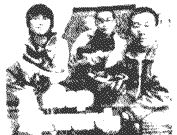阅读短文,选择正确答案。

FIFTEEN YEAR-OLD Liu Xuyang said he has more than 30 pairs of shoes. But some are old. He doesn't
want them any more.
Where should these old shoes go? To the garbage or to be recycled?
This is how Liu began to care about old shoes. He shared his thoughts with his classmates at Beijing No. 35
Middle School, Luo Hao and Yang Mengwei. The three then decided to do some research. They found out that
old shoes can pollute the environment if not recycled properly. Earlier this month,their research paper won
second prize in the Beijing Youth Science and Invention Competition.
The three first spent two weeks designing a questionnaire on how people deal with old shoes and how the
shoes are treated. They gave over 100 questionnaires to the public, to shoemakers, garbage stations and
recycling stations.
Doing the survey, They found that on average (平均), a family throws away 5.17 pairs of shoes each year.
That means millions of old shoes are thrown away a year around the country.
However, most old shoes are not treated properly,according to the students.
"Usually, the old shoes are just burnt or buried (填埋) with other garbage," said Luo.
Most of the shoes are made of chemical materials. If they are burnt or buried,they can give off gas (气) or
other things that pollute the air and rivers,said the students.
They suggest there should be big boxes in cities for people to put old shoes in. The shoes could then be taken
to recycling stations to be treated.
On the other hand, the shoemakers, said the students, could use more environment-friendly material to make
shoes.
1.Liu Xuyang
.
[ ]
A.has fifteen pairs of old shoes
B.has more than thirty pairs of old shoes
C.has more than thirty classmates in his class
D.is a student of No. 35 Middle School in Beijing
2.Liu Xuyang began to care about the old shoes
.
[ ]
A.because he decided to do some research
B.when he wanted to throw away his old shoes
C.because his thirty pairs of shoes were all very old
D.when he sent the shoes to the recycling factory
3.What does the word "questionnaire" mean in the underlined sentence?
[ ]
A.A station to deal with the waste materials.
B.A recycling station to treat the old shoes.
C.An office to deal with the problems of old shoes.
D.A list of questions to be answered by a group of people.
4.How did the three students begin their research?
[ ]
A.They designed a questionnaire first.
B.They wrote a research paper about the old shoes.
C.They gave out the questionnaires and won a prize.
D.They visited many shoemakers, trash and recycling stations.
5.Which of the following is NOT true according to the passage?
[ ]
A.More recycling stations should be built around the country.
B.Old shoes will pollute the environment if not recycled properly.
C.The students' survey shows millions of old shoes are thrown away each year.
D.The students suggest that environment-friendly material should be used to make shoes.